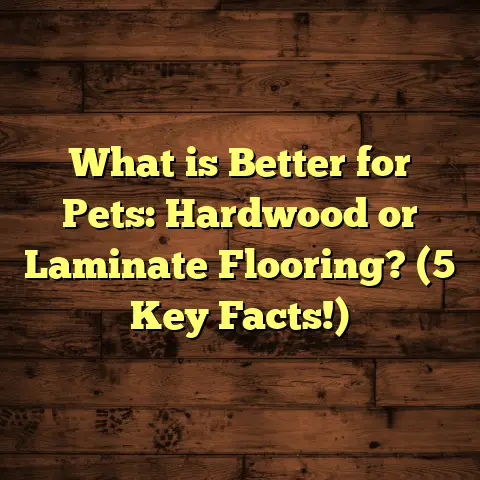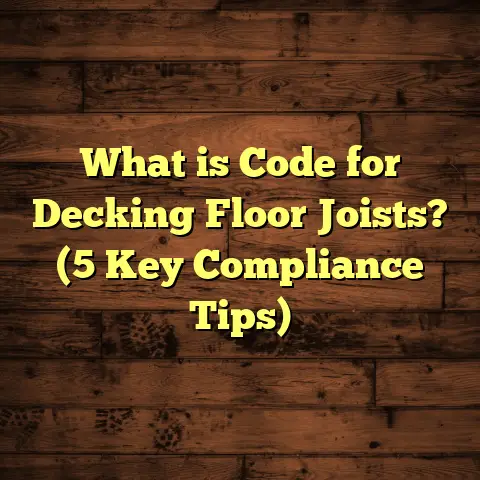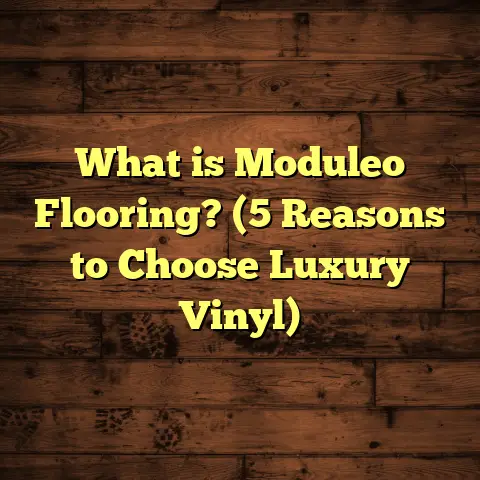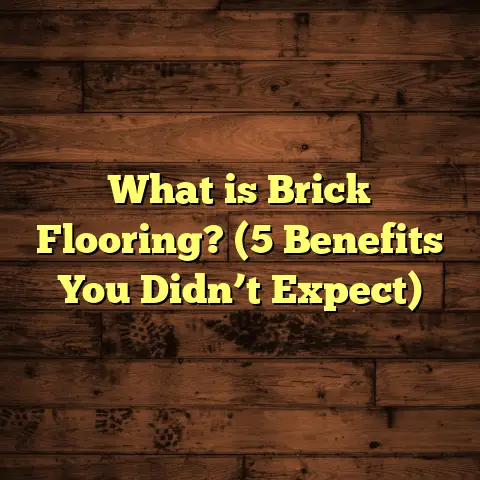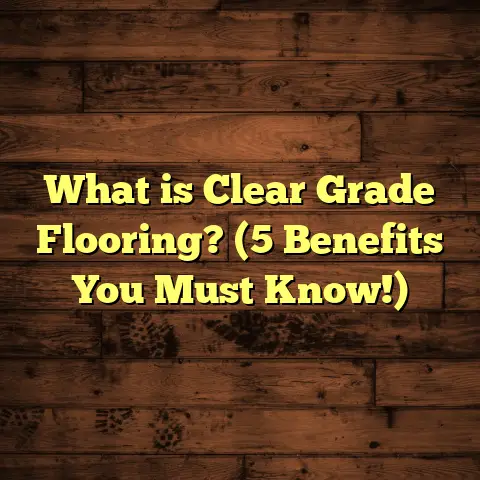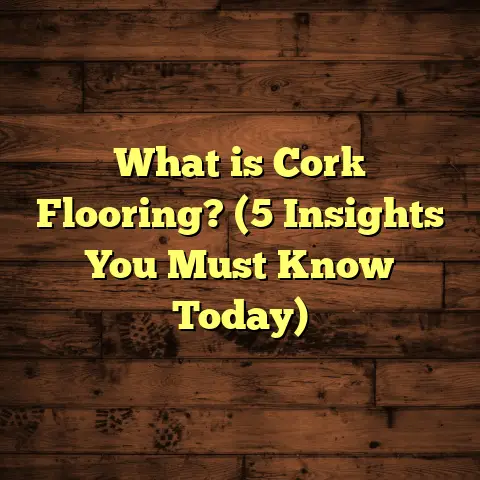What is an LVP Floor? (5 Key Benefits You Didn’t Know!)
You ever notice how we often overlook the flooring under our feet? I used to think floors were just… floors—something you walk on without much thought. Then I got into flooring myself, and let me tell you, the story changed completely. Floors are a huge deal. They affect the look, feel, and even the function of your entire home. One type that caught my attention early on is LVP flooring. You might have heard about it, but do you really know what it is? And more importantly, why so many homeowners and pros like me are choosing it over other options? Let me walk you through it.
What is an LVP Floor?
LVP stands for Luxury Vinyl Plank. At its core, it’s a type of vinyl flooring designed to mimic the appearance of real hardwood planks. But unlike traditional vinyl sheets, LVP comes in rigid planks that look and feel more like wood. The surface has a printed layer with a high-resolution image of wood grain, knots, and textures—so it’s surprisingly realistic.
LVP is typically made of several layers:
- Wear Layer: A clear, protective coating that guards against scratches, stains, and dents.
- Printed Design Layer: This is where the wood look comes from.
- Core Layer: Usually made from PVC or something similar, providing durability and stability.
- Backing Layer: Adds extra moisture resistance and sometimes sound absorption.
The magic lies in the wear layer thickness and the quality of the printed image. Thicker wear layers mean better longevity, especially in high-traffic areas.
I remember my first LVP install—it was for a customer who wanted an affordable yet beautiful alternative to hardwood in their kitchen. The way those planks clicked together without glue or nails blew my mind at the time. Plus, the water resistance was perfect for a space prone to spills.
How LVP Differs from Other Vinyl Flooring
Not all vinyl flooring is created equal. There’s sheet vinyl, luxury vinyl tile (LVT), and luxury vinyl plank (LVP).
- Sheet Vinyl comes in large rolls and is installed mostly glued down or loose-laid. It’s usually less expensive but offers fewer design options and less durability.
- Luxury Vinyl Tile (LVT) resembles stone or ceramic tile but offers the flexibility of vinyl.
- Luxury Vinyl Plank (LVP) mimics wood specifically with plank-shaped pieces.
LVP combines ease of installation, realism in design, and durability better than sheet vinyl or LVT for many residential applications.
5 Key Benefits You Didn’t Know About LVP Flooring
You might be wondering: “Why pick LVP over hardwood, laminate, or tile?” I’ve been installing floors for years, and here are five benefits about LVP that often surprise people.
1. Water Resistance That Surpasses Expectations
Most types of wood flooring don’t do well when exposed to water. Hardwood can warp; laminate swells; tiles can crack grout lines. But LVP? It’s almost waterproof.
In one project I worked on, a family had persistent humidity issues in their basement. Hardwood or laminate wasn’t an option. We installed LVP with a thick wear layer and a waterproof core. After two years, no signs of buckling or damage—even after several floods caused by broken pipes.
Statistically, LVP has a water resistance rating far higher than laminate—up to 100% waterproof depending on the brand and core type.
This makes it ideal for spaces prone to moisture like basements, bathrooms, kitchens, laundry rooms, mudrooms—even commercial spaces like gyms or restaurants where spills are common.
Why does this matter?
Because water damage is one of the leading causes of flooring failure. According to a 2023 study by the National Wood Flooring Association (NWFA), moisture-related issues account for nearly 40% of hardwood floor repairs annually. With LVP’s water resistance, you’re avoiding a major headache before it starts.
2. Durability That Keeps Up With Real Life
People often assume vinyl floors aren’t durable. Sure, cheap vinyl can tear or dent easily. But luxury vinyl plank is a different beast.
The wear layer can range from 6 mil to 30 mil (thousandths of an inch). For reference:
- 6-12 mil wear layers are good for residential use.
- 20-30 mil wear layers suit commercial spaces or very busy homes.
I once installed LVP in a daycare center’s playroom—kids running, jumping, spilling snacks every day—and after nearly three years, the floor still looked great. No dents or scratches from toys or furniture.
From my experience working with homeowners who have pets and kids, I can tell you LVP holds up better than laminate when it comes to scratches and dents. Cats’ claws? Dog nails? No problem.
Furthermore, since LVP has a softer feel than tile or hardwood underfoot, it reduces fatigue if you spend lots of time standing or walking on it. That’s why commercial kitchens sometimes choose it too.
3. Installation Is Surprisingly Simple – Even for DIYers
Here’s where LVP really shines if you like handling projects yourself. Most LVP products use click-lock technology—planks snap together without glue or nails.
When I first tried this method years ago, I appreciated how clean and quick it was compared to traditional wood floors that require nails or glue-ups.
Some planks even come with attached underlayment for soundproofing and cushioning—meaning fewer prep steps.
This ease saves time and money on labor costs.
A couple years ago I helped a friend install LVP in his new rental property. We finished two rooms in one weekend without professional tools or messy adhesives.
Plus, if you ever want to replace a damaged plank later on, you can easily pop one out and swap it without ripping up the whole floor.
4. Budget-Friendly Without Looking Cheap
Hardwood flooring prices vary widely but generally start around $8 per square foot for materials alone—and installation can double that.
LVP usually costs between $2 to $7 per square foot depending on brand and quality. Add installation costs, and you’re often looking at half or less than hardwood for a similar look.
I use tools like FloorTally to estimate my projects now—it helps me quickly get accurate local cost estimates including materials and labor. It even factors in waste percentages so I don’t order too much or too little. This tool has saved me hours of back-and-forth quoting with suppliers and helped me give clients realistic budgets upfront.
In fact, on an average 1,000-square-foot project with mid-range LVP:
- Material cost: ~$4,000
- Labor cost: ~$2,000
- Total: ~$6,000
Compare that to hardwood at $12 per square foot installed = $12,000 total — quite a difference!
5. Design Variety That’ll Blow Your Mind
When most people think vinyl flooring, they imagine plain sheets with limited style. LVP laughs at that stereotype.
Thanks to advances in printing technology, LVP can mimic not just oak or maple but exotic woods like hickory and walnut—right down to tiny grain details.
Some brands even offer textured surfaces that feel like real wood grain under your feet.
A client once told me they couldn’t believe their “wood” floor wasn’t real because it felt so authentic even when barefoot.
Plus, LVP comes in wide planks and narrow strips, matte or glossy finishes—giving you tons of design freedom.
And there are even options for patterns like chevron or herringbone that used to be exclusive to real hardwood floors.
Breaking Down Installation: How I Use FloorTally to Get It Right Every Time
Estimating flooring projects used to be a huge pain for me.
I’d spend hours calling suppliers for prices, calculating waste percentages manually,
and trying to guess labor rates locally.
Then I found FloorTally—a tool designed specifically to take all those headaches away.
When planning an LVP install now,
I input project size,
choose my material type,
add local labor rates,
and the tool spits out detailed cost estimates within minutes.
It even includes waste factor calculations,
which means I buy just enough material without over-ordering (which wastes money)
or under-ordering (which delays projects).
For example,
a recent kitchen remodel required about 200 sq.ft of LVP.
FloorTally told me I needed 220 sq.ft with waste included based on plank size,
cuts,
and layout patterns.
This saved me from ordering too little material and having to rush for last-minute purchases at premium prices.
The interface is clean and straightforward,
so even clients can understand estimates clearly,
making budgeting easier for everyone involved.
Personal Case Study: A Basement Transformation with LVP
One of my favorite projects took place in a damp basement converted into a family room.
The homeowners wanted something warm-looking but also practical with moisture issues below grade.
We ruled out hardwood immediately due to potential warping risks,
and tile felt too cold and hard for their kids’ play area.
LVP was perfect because:
- Waterproof core handled moisture without warping
- Soft surface made it safer for children
- Easy installation minimized downtime
After installation,
the family reported no signs of mold or mildew after two years despite occasional flooding,
and the floor still looked brand new despite heavy use by their toddlers and pets.
They told me they never imagined vinyl could look so good or last this long in such conditions.
Comparing LVP with Other Popular Flooring Options
Here’s a deeper look at how LVP stacks up against similar floors:
| Feature | LVP | Hardwood | Laminate | Tile |
|---|---|---|---|---|
| Cost per sq.ft | $2-$7 | $8-$20 | $6-$12 | $10-$25 |
| Installation Ease | DIY-friendly click-lock | Requires professional | DIY-friendly click-lock | Professional required |
| Water Resistance | High (up to waterproof) | Low | Medium (not waterproof) | Very high |
| Durability | High with thick wear layer | Very high (can refinish) | Medium | Very High |
| Maintenance | Very low | Moderate (refinishing) | Low | Moderate (grout cleaning) |
| Realistic Wood Look | Excellent | Natural | Good | N/A |
| Comfort Underfoot | Softer than tile/wood | Hard | Hard | Hard |
| Resale Value Impact | Moderate | High | Low | Moderate |
This table helped many of my clients decide based on what mattered most—budget, durability, moisture concerns, or resale value.
The Science Behind LVP’s Durability
You might wonder what exactly makes some LVP floors so tough?
It comes down to materials science:
- The wear layer is usually made from urethane or aluminum oxide coatings which resist abrasion and stains.
- The core layer, especially if it’s SPC (Stone Plastic Composite), has limestone added for rigidity and impact resistance.
- Some brands add UV protection to prevent fading from sunlight exposure.
- The backing layer often includes soundproofing materials reducing noise reverberation—a bonus in multi-story homes or apartments.
In tests performed by flooring labs:
- High-quality LVP resists scratches from steel wool pads.
- It shows minimal color fading after prolonged UV exposure.
- Impact tests simulating dropped pots show no cracking or denting on SPC-based cores versus traditional vinyl.
Knowing these details helped me recommend specific brands for commercial clients needing tough floors that last under heavy traffic while maintaining beauty over time.
Real Talk: Are There Downsides?
I want to be honest here because no floor is perfect.
Some downsides I’ve noticed include:
- Less warmth than hardwood: Wood floors naturally hold heat better than vinyl. You might want area rugs in colder climates.
- Can dent under very heavy furniture: If furniture legs aren’t padded correctly.
- Lower resale value compared to hardwood: Some buyers still prefer real wood.
- Environmental concerns: Vinyl is made from PVC plastic which isn’t biodegradable; recycling options remain limited.
That said, ongoing innovation is making eco-friendly versions available now with recycled content and better life-cycle assessments.
Tips For Maintaining Your LVP Floor
Keeping your floor looking good is simple but worth doing right:
- Sweep or vacuum regularly to remove dirt that can scratch the surface.
- Clean spills immediately with a damp cloth—don’t let liquids sit.
- Use manufacturer-approved cleaners; avoid harsh chemicals or abrasive tools.
- Place felt pads under furniture legs.
- Avoid dragging heavy items across the floor.
- Consider area rugs in entryways to catch dirt early.
These small habits have kept many of my clients’ floors looking new well past their expected lifespan.
Frequently Asked Questions About LVP Flooring
Q: Can I install LVP over existing floors?
A: Often yes! As long as the existing floor is flat, clean, and dry you can install LVP over tile, concrete, or wood subfloors which can save demolition time and costs.
Q: How long does LVP last?
A: With proper care and depending on wear layer thickness, expect between 15-30 years from residential-grade products; commercial grades last even longer.
Q: Is LVP eco-friendly?
A: Traditional vinyl isn’t biodegradable but newer products include recycled content; always check brand certifications if sustainability matters to you.
Q: Does LVP feel cold like tile?
A: It’s warmer than tile but not as warm as hardwood; underfloor heating systems work well with LVP if needed.
Final Thoughts
If you ask me what makes LVP floors special,
it’s the balance of beauty,
practicality,
and cost-efficiency that really stands out.
Whether you want a water-resistant floor for your bathroom,
an easy-to-install upgrade for your rental property,
or simply want that classic wood look without breaking the bank,
LVP deserves your attention.
If you’re curious about costs or want to play around with design options,
tools like FloorTally have been game changers for me in planning projects efficiently and accurately.
So next time someone asks me about flooring options,
I don’t hesitate to bring up luxury vinyl plank as one of the smartest choices out there.
Have you tried LVP in your home? What did you think?
